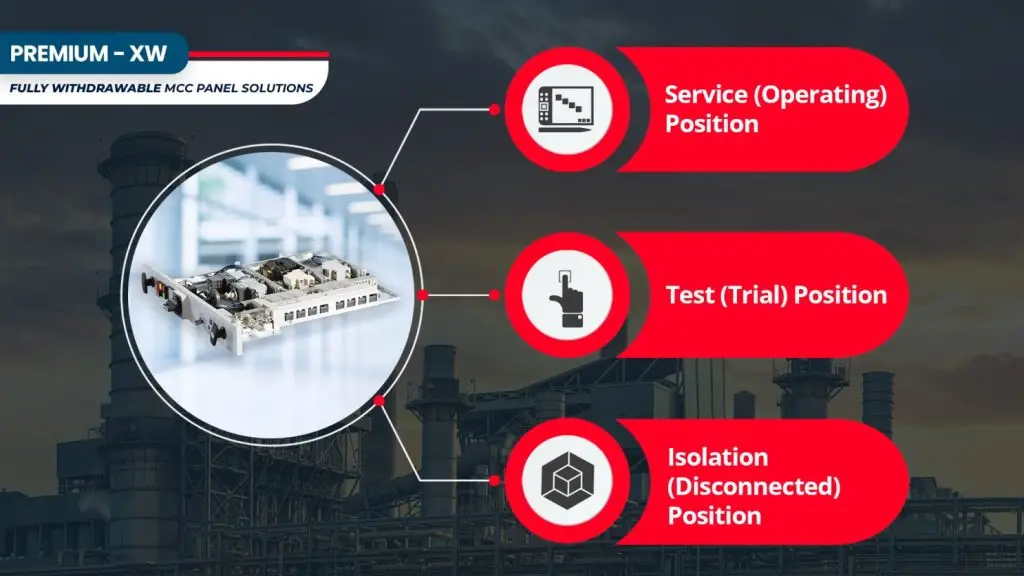PREMIUM-XW: The New Standard in High Performance, Durability and Reliability!
Fully Withdrawable MCC Technology is the latest innovative step in GVD’s leading low voltage switchgear series.
Premium-XW fully withdrawable systems are equipped with user-friendly design and secure locking mechanism. This feature prevents abuse and maximizes system security. It combines advanced technology and aesthetic design, allowing you to manage your electrical panels safely.
Premium-XW’s drawer modules can be easily installed and removed and eliminate the need for complex cabling in classic connection systems. Its technological principles ensure long-lasting use by minimizing material wear.
Technical Specifications of the Withdrawable System:
Modular Structure: Each drawer is configured to manage a single function (e.g., motor control, fuse circuit, compensation, etc.).
Standardized Dimensions: 1/4, 1/2, 3/4, and full drawers can be arranged as needed with different height options.
High Load Capacity: Each drawer has undergone thermal testing in accordance with its rated current.

Triple Position Mechanism:
- Service (Operating) Position
- Test (Trial) Position
- Isolation (Disconnected) Position
Each drawer is supported by a mechanical system for easy access.
Safety Equipment: Mechanical interlocking, arc-blocking contacts, and control circuit safety systems ensure maximum user safety.

Ease of Use:
Plug-and-Play Principle: Each drawer is ready to use once integrated into the main system. No complex wiring is required.
Tool-Free Replacement: Thanks to the specially designed rail system, the user can easily remove or install the drawer.
Front Panel Access: All drawers are accessible via the front panel, eliminating the need to walk behind the cabinet.
Color-Coded Indicators and Labels: Drawer positions can be clearly visually monitored.
Withdrawable System Advantages:
Uninterruptible Power: A faulty drawer can be removed and replaced without interrupting system power. This feature is particularly advantageous in critical facilities (hospitals, data centers, production lines).
Ease of Maintenance: Modules that are faulty or require periodic inspection can be quickly removed from the system. There’s no need to take the entire panel offline.
Space Efficiency: The compact design allows multiple drawer modules to be installed in a single panel.
Reducing the Risk of Error: By placing pre-tested modules in the drawers, potential errors during field wiring and commissioning are minimized.
Easy Backup: Spare drawers can be kept ready for frequently used or critical modules. Replacement can be done in minutes if necessary.

Situations Where It Provides Advantage:
In Cases of Fault: A solution is achieved with minimal service time by intervening only on the relevant drawer without shutting down the system.
In Systems Requiring Frequent Replacement: Functional modules used in motor control, automation, or other scenarios can be easily replaced.
In Applications Requiring High Energy Continuity: Systems such as data centers, critical production lines, or public infrastructure must be accessible while operating. Withdrawable systems meet this requirement most securely.
In Testing and Commissioning: Functional checks can be performed by operating each drawer in a “test position.” Fault detection can be achieved without de-energizing the system.
In Facilities Requiring Expansion and Renovation: When adding a new circuit or load, the system can be expanded with new drawers without completely replacing the panel.

How to Use – Operation and Maintenance Process:
Installation: The drawer is secured to the system using a rail structure. The main and auxiliary contacts automatically make contact according to the relevant position.
Position Selection:
- In the service position, power is applied and the module operates.
- In the test position, only the auxiliary circuits are active, allowing for functional checks.
- In the isolated position, all connections are disconnected.
Maintenance: The relevant drawer is removed from the system, and the faulty component or equipment is replaced while still outside the module. The replacement module is inserted and placed in the service position, and the system is reactivated.
Control and Monitoring: Status monitoring can be performed using indicators, thermal relays, and protection modules.


